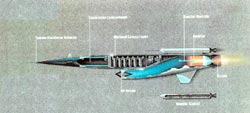|
Airframe
 No airframe had been designed to operate in the environment of Mach 3 at sea level where skin temperatures reach 1,000 Fahrenheit and the sound pressure level is on the order of 162 db. Aerodynamics in this flight regime was little explored. Almost 1600 hours of wind tunnel testing in all the national laboratories resulted in a canard configuration design that could operate in the planned flight profile. The classical spike inlet was replaced with a scoop-type inlet invented in the program, which gave pitch/yaw performance over a wider range and a pressure recovery of 86% that was much higher than the initial program objective. An extensive materials investigative program resulted in the selection and fabrication of a section of fuselage using Rene 41 stainless steel with a skin thickness of 1/10 to ¼ inch. This was strength- tested in a furnace to simulate aerodynamic heating. Forward sections of the missile were to be gold plated to dissipate heat by radiation. A 1/3-scale model of the missile nose, inlet and duct was constructed and wind tunnel tested. No airframe had been designed to operate in the environment of Mach 3 at sea level where skin temperatures reach 1,000 Fahrenheit and the sound pressure level is on the order of 162 db. Aerodynamics in this flight regime was little explored. Almost 1600 hours of wind tunnel testing in all the national laboratories resulted in a canard configuration design that could operate in the planned flight profile. The classical spike inlet was replaced with a scoop-type inlet invented in the program, which gave pitch/yaw performance over a wider range and a pressure recovery of 86% that was much higher than the initial program objective. An extensive materials investigative program resulted in the selection and fabrication of a section of fuselage using Rene 41 stainless steel with a skin thickness of 1/10 to ¼ inch. This was strength- tested in a furnace to simulate aerodynamic heating. Forward sections of the missile were to be gold plated to dissipate heat by radiation. A 1/3-scale model of the missile nose, inlet and duct was constructed and wind tunnel tested.
A preliminary inboard design of the complete weapon system missile was made to show location of all equipment and hardware, including the hydrogen weapons. A detailed and final design would have been required.
SLAM Description:
Airframe
Electronics and Guidance
Radiation and Reactor
Muscle in Mothballs
SLAM Flight Profile
|